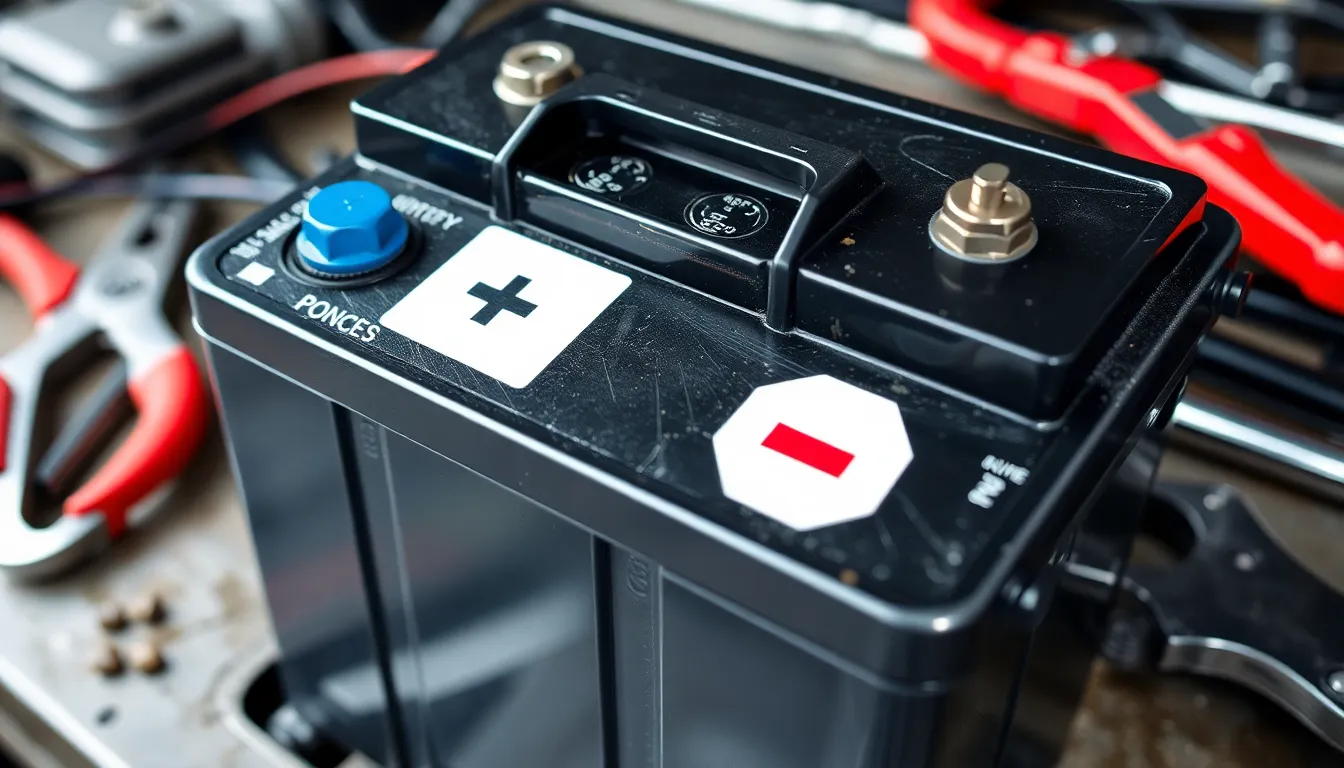When it comes to batteries, knowing which terminal is which can save you a shocking amount of trouble. Picture this: you’re ready to jump-start your car, but instead of reviving your ride, you end up creating a fireworks show. Not fun, right? Understanding the positive and negative battery terminals isn’t just useful; it’s essential for anyone who wants to avoid a dramatic (and potentially explosive) mishap.
Table of Contents
ToggleUnderstanding Battery Terminals
Battery terminals play a crucial role in the functionality of batteries. Each battery consists of two terminals: a positive terminal, marked with a plus sign (+), and a negative terminal, marked with a minus sign (-). Identifying these terminals helps users connect devices correctly.
Positive terminals provide electrical current, while negative terminals serve as the return path for that current. Incorrect connections can reverse the flow, leading to potential damage or hazardous situations. Many batteries have color coding to aid identification, with red indicating positive and black indicating negative.
A common scenario involves jump-starting a vehicle. In this case, connecting the red clamp to the positive terminal and the black clamp to the negative terminal is vital. This practice prevents short circuits and facilitates a safe transfer of power. Understanding the specific order of connection enhances safety during this process.
Visual aids, such as diagrams, clarify the arrangement of battery terminals. Many diagrams demonstrate the correct methods for connecting and disconnecting battery cables. Examples in these diagrams often depict the negative terminal grounded to the car’s body, ensuring stability during use.
Remember that maintaining battery health requires regular checks on terminal cleanliness. Corrosion buildup can hinder connectivity, causing unreliable performance. Cleaning terminals with a mixture of baking soda and water helps restore functionality and ensures consistent energy transfer.
Familiarity with battery terminals culminates in safer interactions with batteries. Knowledge empowers users to handle batteries confidently, avoiding mishaps and ensuring operational efficiency in various applications.
Importance of Positive and Negative Terminals

Understanding positive and negative battery terminals is crucial for safe battery usage. Their proper identification prevents accidents and ensures devices function correctly.
Function of Positive Terminal
The positive terminal serves as the starting point for electric current flow in a circuit. Identified by a plus sign, it connects to the battery’s anode. When users attach a device, they connect its positive cable to this terminal to enable electricity flow. Devices rely on this connection to receive power from the battery. Mishandling the positive terminal can lead to malfunction, damage, or potentially dangerous situations.
Function of Negative Terminal
The negative terminal plays a vital role in completing the electrical circuit. Marked with a minus sign, it connects to the battery’s cathode. This terminal allows excess electric charge to return to the battery, maintaining a balanced system. When users connect a device, they attach its negative cable to the negative terminal to ensure proper operation. Failure to correctly connect can hinder performance and cause issues like short circuits or equipment failure.
Common Diagrams of Battery Terminals
Understanding the common battery terminal diagrams aids in correct connections. Visual representations simplify identifying terminals and enhance safety during use.
Standard Battery Diagrams
Standard battery diagrams typically depict a rectangular shape. The positive terminal, marked with a plus sign or red color, appears on one side. Opposite this, the negative terminal appears, marked with a minus sign or black color. These diagrams often illustrate the flow of electricity from the positive terminal to the negative terminal. Clarity in these diagrams helps effectively communicate proper connections and serves as a reference for safe practices.
Variations in Different Battery Types
Variations exist among different battery types, affecting terminal layouts. For example, automotive batteries often feature top posts while some applications utilize side terminals. Each battery type may have unique labeling methods, including colors or symbols to differentiate terminals. Additionally, specific battery technologies, like lithium-ion versus lead-acid, require different considerations. Understanding these variations ensures users confidently handle various batteries in distinct operational contexts.
Safety Considerations
Understanding battery terminals requires awareness of safety measures. Incorrect connections can lead to sparks or explosions. Always identify the positive terminal, marked with a plus sign, and the negative terminal, marked with a minus sign. Red indicates positive while black represents negative. This color coding helps prevent accidents during battery maintenance.
When jump-starting a vehicle, follow a specific procedure to ensure safety. Connect the red cable to the positive terminal on the dead battery first. Next, attach the other end of the red cable to the positive terminal of the functional battery. Attach the black cable to the negative terminal of the functional battery. Finally, connect the remaining end of the black cable to a grounded metal surface on the dead vehicle to prevent short circuits.
Maintaining battery terminals contributes to performance. Corrosion builds up on terminals and can disrupt electrical connections. Regular cleaning using a mixture of baking soda and water helps eliminate corrosion. Ensuring terminals are tight and clean promotes optimal functioning.
Familiarity with common battery diagrams enhances understanding. Standard diagrams typically show the positive terminal on one side and the negative on the opposite. Knowing this arrangement assists in safe connections. Variations can occur, especially with automotive batteries featuring top posts or side terminals. Being aware of these differences fosters confidence in handling various battery types.
Using visual aids can clarify terminal identification. Diagrams visually represent the correct connection methods, serving as helpful references. Ignoring established procedures may lead to dangerous situations. Safety should always be a priority when dealing with batteries.
Understanding the positive and negative battery terminals is essential for anyone working with batteries. This knowledge not only enhances safety but also prevents costly mistakes. By recognizing the importance of color coding and following proper procedures for connections, individuals can avoid dangerous situations.
Utilizing diagrams can significantly simplify the identification process and improve confidence when handling various battery types. Regular maintenance of battery terminals ensures optimal performance and longevity. With the right information and precautions, anyone can manage batteries effectively, keeping safety as a top priority.





